







|

|

|

|

|

|

|
Speciality "Software engineering"
|
||||
|
|
|||||
|
Existing parallel programming libraries and systems, such as, written for C and Fortran, MPI (Message Passing Interface) implementations or, for example, NESL, Charm++ are low-leveled, oriented only to the procedural or functional programming model[1] and, thus, not consonant with the modern object-oriented style application developing. On this stage in the direction of new models of parallelism creation it is important to mention the model of the concurrent programming, offered by Nick Benton, Luca Cardelly and Cedric Fournet – Polyphonic C#[2]. This model is based on join-calculations and, so-called «asynchronous» methods which can be executed in the separate thread. The parallel programming system Spring PPI (Spring Parallel Programming Interface)[3] is also based on the model of synchronous and asynchronous (distance- in terminology of Spring PPI) methods, however the specific feature of the system is transfer of asynchronous methods execution on the other computer (node of cluster), and also provide the programmer high-level mechanism of co-operations (massage passing) between asynchronous methods. The distinguishing feature of the system is implementation of parallel programming patterns (standard methods). Thus, the system allows a programmer to use easily tested approaches of parallel programs design and to think at higher abstract level while developing algorithms.
Spring PPI system is written on C# and consists of 2 programming modules: the system of cluster administration (Run-time of the system) and concurrent programming framework. Thus, Spring PPI is: 1) parallel programming framework – is .NET assembly to connect to the cluster program-client and providing high-leveled concurrent programming interface; 2) Cluster administrator (ClusterAdministrator) is the program, started on the front cluster host and responsible for management of cluster calculable resources between programs-clients requests; 3) Cluster working node (ClusterLeaf) is the program, working on every cluster computer and responsible for execution of asynchronous methods, I.e. providing basic calculable function on every cluster node. Conceptually the deployment diagram of Spring PPI system is illustrated on fig. 1.
 Spring PPI is realized, based on work with ports, and doesn’t use .NET Remoting, MSMQ, Indigo or other technology for remote co-operation between computers. Remote asynchronous method calls is based on reflection mechanisms. The scheme of asynchronous method call in Spring PPI is presented on animation 1.

1. Singleton Singleton[14] is base, elementary pattern which encapsulates execution of one remote method on a cluster.
2. Pipeline

3. Master-Slave
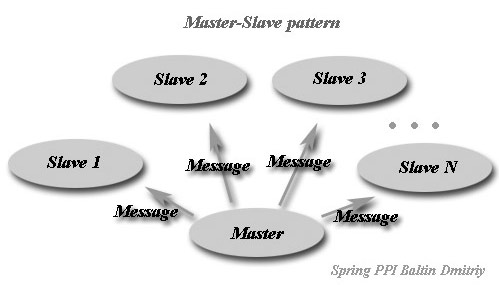
4. Divide and Conquer
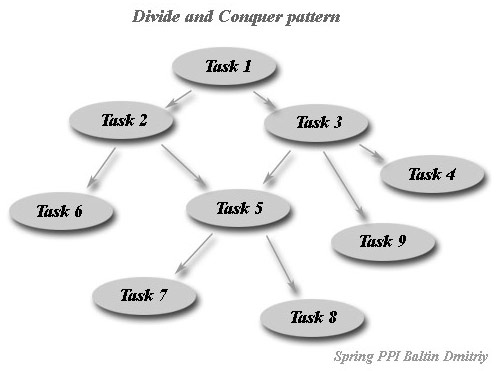
5. Repository
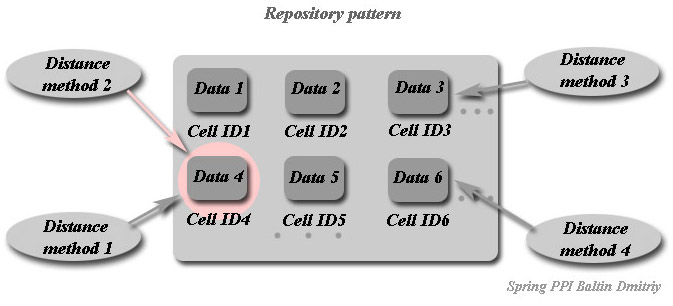
As an example for the estimation of work of the system were realized three known algorithms of matrix multiply: Fox, Cannon and striped. All algorithms were realized using Master-Slave and Repository patterns. Every algorithm was started on 1, 2 and 4 processors. Experiments were conducted on a cluster, based on local network (100 Ìb/s) and computers with processors - 2.4 GHz. Figures 6, 7, 8 present scale capability for each of the algorithms
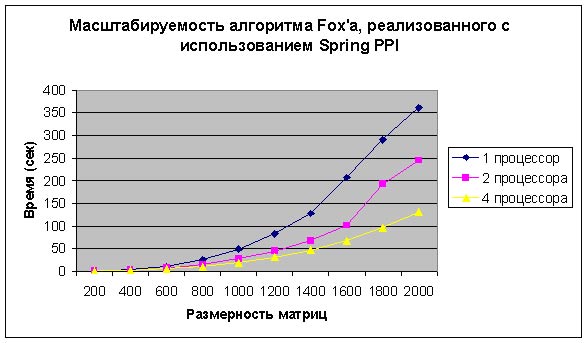
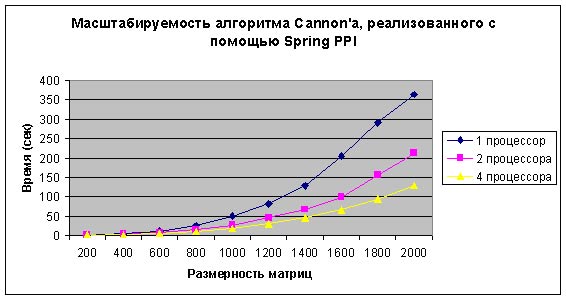
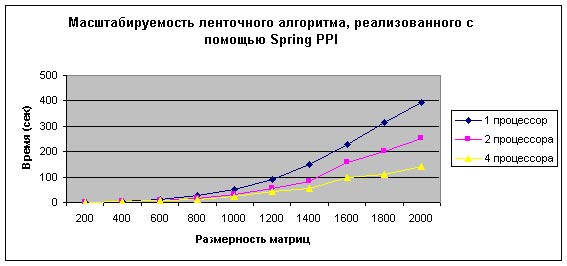 Thus, Cannon and Fox algorithms showed good scale capability, I.e. at twice increasing of the number of calculable nodes (processors) – time of algorithm execution time reduced twice. Thus, it on the example of three known algorithms of matrix multiply was shown, that Spring PPI Run-time system is scalable system.
During the work of master's degree dissertation the system of the concurrent programming - Spring PPI - was developed. Spring PPI realizes a high-leveled parallel programming model. This model uses the concept of remote (distance) method, method which is executed on a cluster. Thus, a model is fully integrated with the object-oriented design approach. During the dissertation work, was theoretically and practically grounded the necessity of parallel programming patterns using. Using patterns is a method to make programs development process more universal, reduce the complexity of parallel programs. Framework Spring PPI implements parallel programming patterns: Singleton, Master-Slave, Pipeline, Divide and Conquer and Repository. As demonstration of the offered pattern based parallelism model were realized the classic algorithms of parallel matrix multiply: Fox algorithm, Cennon’s algorithm and striped algorithm. All three algorithms showed high scalability level, thus, we can say about scalability of Spring PPI Run-time system. During further implementation of master's degree dissertation work will be conducted on developing and researching of parallel model to access and processing data using relational database as the source. Further Spring PPI will be applied for realization of parallel versions of book-keeping algorithms.
1. Foster I. Designing and Building Parallel Programs. — Addison Wesley. 2. Modern Concurrency Abstractions for C# In B. Magnusson (Ed.), Proceedings of the 16th European Conference on Object-Oriented Programming (ECOOP 2002). University of Malaga, Spain. LNCS 2374, Springer-Verlag Nick Benton, Luca Cardelli, Cedric Fournet, Microsoft Research, Cambridge 3. Spring PPI site http://springppi.dimetrius.com.ua/ 4. Parallel Programming Portal http://parallel.ru/ 5. Voevodin V.V. Ïàðàëëåëüíûå âû÷èñëåíèÿ. - SPb.: BHV, 2002. 6. Official site MPI - MPICH http://www-unix.mcs.anl.gov/mpi/mpich/ 7. Multiprocessor MPI implementation - MP-MPICH http://www.lfbs.rwth-aachen.de/content/mp-mpich 8. MPI for Windows – WMPI : http://dsg.dei.uc.pt/wmpi 9. Official site PVM http://www.epm.ornl.gov/pvm 10. Project BSPlib http://www.bsp-worldwide.org/implmnts/oxtool/ 11. BSP standart http://web.comlab.ox.ac.uk/oucl/work/bill.mccoll/oparl.html 12. Official site OpenMP http://www.openmp.org 13. Massingill, B.L., Mattson, T.G., Sanders, B.A.: A pattern language for parallel application programming. Technical Report CISE TR 99-022, University of Florida, 1999 14. Massingill, B.L., Mattson, T.G., Sanders, B.A.: More Patterns for Parallel Application Programs PLoP 2001 15. Martin Fowler. Refactoring: Improving the Design of Existing Code. Addison-Wesley Professional, 1st edition, 1999. With contributions by Kent Beck, John Brant, William Opdyke, and Don Roberts.
|
|||||
| Biography | Abstract | Library | Links | Search Report | Individual Task |